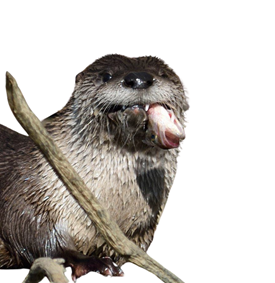Smithsonian Health Connections & River Otters
SERC is a part of a multi-unit Smithsonian initiative called “Smithsonian Health Connections”. The Smithsonian has researchers around the world looking at how humans affect animal health and diseases and vice versa.
The newly formed Chesapeake Bay Otter Alliance (CBOA) is a part of this initiative at SERC. It brings scientists from a variety of disciplines and organizations to learn about the ecology and biology of river otters of the Chesapeake Bay, including the National Zoo, the Smithsonian Conservation Research Center, the National Museum of Natural History, the Arundel Rivers Federation, the Urban Waterways group, Frostburg State University, and private citizens. The Alliance will greatly expand our understanding of how humans impact these otters that live both on land and in water. Research will include the ways transmission of marine diseases and parasites affect entire food webs and ecosystems.
Let us bring real-world science into your classroom with fun hands-on learning. We’ll teach students using scientific research techniques, including data literacy (from collection to analysis), with data sets you can use with your classes.
Professional Development
Teacher Professional Development: Using Game Cameras in and out of the Classroom to Track Animal Abundance
Grades: Teaching grades 3rd-12th
Duration: Two half-day classes
We’ll cover how to use game cameras in your classroom, school, or location for onsite and remote teaching. We will go through everything from how to choose a camera to setting up and analyzing data with students.
**This class is also offered as a part of our “Movement of Life” programs about migration and tracking wildlife.
Talk
Introduction to River Otters of the Chesapeake Bay
Grades: Adaptable for bands 3rd-5th, 6th-8th, 9th-Adult
Duration: 1 hour
In this program, we will delve into river otter ecology, food webs, and adaptations for living in the Chesapeake Bay. For younger students, we’ll focus on river otter adaptations for living in water and on land.

Stem Lab Classes
Marine Ecology: Otter Scat Dissection for the Classroom
Grades: Adaptable for 3rd-8th
Duration: 1 hour
Scat analysis offers our SERC scientists a window in the food webs of the Chesapeake Bay, using the remains found in otter poo. In this class we’ll learn about otter diets and how to use fish scales like fingerprints. Then our educator will dissect a cleaned and dried poo sample and discuss what is found.
For an additional fee, we will send you a sample for your classroom. The cost is $5 per class, plus $5 shipping. For a sample for each student, the cost is $20 for a class of 30, plus $5 shipping. All samples are washed, sanitized, and baked clean.
Game Camera Set-up and Use by Students
Grades: Adaptable for 6th-12th
Duration: 2-4 hours, customizable
In this training with your students, we’ll go over how to place and use game cameras to collect data, and how to process that data. This class can be broken into two sections: a pre-reading component and post-class model data sheet. We will also provide you with a list of camera types (ranging from $40-$100) that you can buy for your classroom. Or, for $80, we will provide you with a camera.
**This class is also offered as a part of our “Movement of Life” programs about migration and tracking wildlife.
Science Literacy, Data Collection, & Basic Statistics
Animal Behavior Lab: Data Collection, 3rd-5th Grade
What Data Can Be Collected from River Otter Camera Videos?
Grades: Adaptable for 3rd-5th
Duration: 1.5 hours
We will learn about river otters of the Chesapeake Bay, and then look at game camera videos from SERC. Students will learn about quantitative and qualitative data, figure out what data they can collect, and then work in teams to collect data from specific data sets of videos. You can take this data with you and use it for your classroom for further lessons.
Animal Behavior Lab: Data Collection & Class Project, 6th-12th Grade
Video Analysis and Data Collection of Game Camera Footage of River Otters & Raccoons
Grades: Adaptable for 6th-12th
Duration: 2 hour program in class and suggested one hour homework time
We will learn about river otters of the Chesapeake Bay, and then look at game camera videos from SERC. Students will learn about quantitative and qualitative data and figure out what data they can collect. They will then be broken out in teams and given two data sets of videos (45 sec. each), one for 2020 and one for 2021. Students will answer the question, “What is the difference in animal abundance, and activity, of raccoons and otters in the same months of 2020 and 2021?” Students will start their project in class, and then work independently to analyze the data from their data sets. You can take this data with you and use it for your classroom for further lessons and presentations.
Basic Statistics, 5th-8th Grade
Understanding Statistics Using Game Camera Footage of Otters
Grades: Adaptable for 5th-8th
Duration: 1-2 hour class, customized
This class is designed to be either a stand-alone or to support the animal behavior labs where students collected data from river otter videos. In this class, students will statistically analyze game camera video data of river otters and raccoons on our SERC Docks. Based on where your class is mathematically, we can cover, mean, median, mode, relative abundance, and a simple T-test, if time allows. We will provide a data set for the students if you don’t have one from the animal behavior labs.
Science Literacy
How to Read a Scientific Paper about River Otter Behavior
Grades: Adaptable for 8th-12th
Duration: 1.5 hours
Let us help your students better understand the best way to read a scientific paper for understanding. We will learn about the abstract, how to pick out key information, and how to find information without needing to be a science expert. We’ll focus on a SERC research paper that analyzed game camera data on our Chesapeake Bay river otters.
